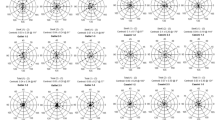Abstract
To compare the precision among currently available keratometry devices. The corneal power was measured on two separate visits with the Nidek TonoRef II Autorefractor/Keratometer, the Zeiss IOLMaster 500, the Haag-Streit Lenstar LS 900, the Oculus Pentacam, and the Oculus Keratograph 4M. The precision was evaluated as the mean absolute intersession difference (MAD) between the corneal power measurements for each patient. Only the non-operated eye was included in the study. The Keratograph was found to have the highest MAD (0.215 D), which was significantly different from the other devices except for the IOLMaster. Nidek ARK had the lowest MAD (0.097 D), but this was not significant compared to Pentacam (0.124 D), Lenstar (0.132 D), or IOLMaster (0.140 D). Only one out of 29 patients had a precision difference exceeding 0.25 D with the Nidek ARK. Among the devices studied, the Nidek ARK was found to have the highest and the Keratograph was found to have to the lowest precision for the measurement of corneal power.

Similar content being viewed by others
References
Olsen T (2007) Calculation of intraocular lens power: a review. Acta Ophthalmol Scand 85:472–485
Lam S, Gupta BK, Hahn JM et al (2011) Refractive outcomes after cataract surgery: Scheimpflug keratometry versus standard automated keratometry in virgin corneas. J Cataract Refract Surg 37:1984–1987
Shammas HJ, Hoffer KJ, Shammas MC (2009) Scheimpflug photography keratometry readings for routine intraocular lens power calculation. J Cataract Refract Surg 35:330–334
Buckhurst PJ, Wolffsohn JS, Shah S et al (2009) A new optical low coherence reflectometry device for ocular biometry in cataract patients. Br J Ophthalmol 93:949–953
Rabsilber TM, Jepsen C, Auffarth GU et al (2010) Intraocular lens power calculation: clinical comparison of 2 optical biometry devices. J Cataract Refract Surg 36:230–234
Cruysberg LPJ, Doors M, Verbakel F et al (2010) Evaluation of the Lenstar LS 900 non-contact biometer. Br J Ophthalmol 94:106–110
Wang Q, Savini G, Hoffer KJ et al (2012) A comprehensive assessment of the precision and agreement of anterior corneal power measurements obtained using 8 different devices. PLoS One 7(9):e45607
Symes RJ, Ursell PG (2011) Automated keratometry in routine cataract surgery: comparison of Scheimpflug and conventional values. J Cataract Refract Surg 37:295–301
Elbaz U, Barkana Y, Gerber Y et al (2007) Comparison of different techniques of anterior chamber depth and keratometric measurements. Am J Ophthalmol 143:48–53
Karunaratne N (2013) Comparison of the Pentacam equivalent keratometry reading and IOL Master keratometry measurement in intraocular lens power calculations. Clin Exp Ophthalmol 41(9):825–834
Symes RJ, Say MJ, Ursell PG (2010) Scheimpflug keratometry versus conventional automated keratometry in routine cataract surgery. J Cataract Refract Surg 36:1107–1114
Shirayama M, Wang L, Weikert MP et al (2009) Comparison of corneal powers obtained from 4 different devices. Am J Ophthalmol 148:528–535
Shammas HJ, Chan S (2010) Precision of biometry, keratometry, and refractive measurements with a partial coherence interferometry–keratometry device. J Cataract Refract Surg 36:1474–1478
Shirayama M, Wang L, Koch DD et al (2010) Comparison of accuracy of intraocular lens calculations using automated keratometry, a Placido-based corneal topographer, and a combined Placido-based and dual Scheimpflug corneal topographer. Cornea 29:1136–1138
Savini G, Barboni P, Carbonelli M et al (2009) Accuracy of Scheimpflug corneal power measurements for intraocular lens power calculation. J Cataract Refract Surg 35:1193–1197
Hsieh YT, Wang IJ (2012) Intraocular lens power measured by partial coherence interferometry. Optom Vis Sci 89:1697–1701
Acknowledgments
Jonas V. Laursen received a grant from Grosserer Chr. Andersens Legat (fund), Copenhagen, Denmark. No author has a financial or proprietary interest in any material or method mentioned.
Author information
Authors and Affiliations
Corresponding author
Rights and permissions
About this article
Cite this article
Laursen, J.V.N., Jeppesen, P. & Olsen, T. Precision of 5 different keratometry devices. Int Ophthalmol 36, 17–20 (2016). https://doi.org/10.1007/s10792-015-0069-3
Received:
Accepted:
Published:
Issue Date:
DOI: https://doi.org/10.1007/s10792-015-0069-3




